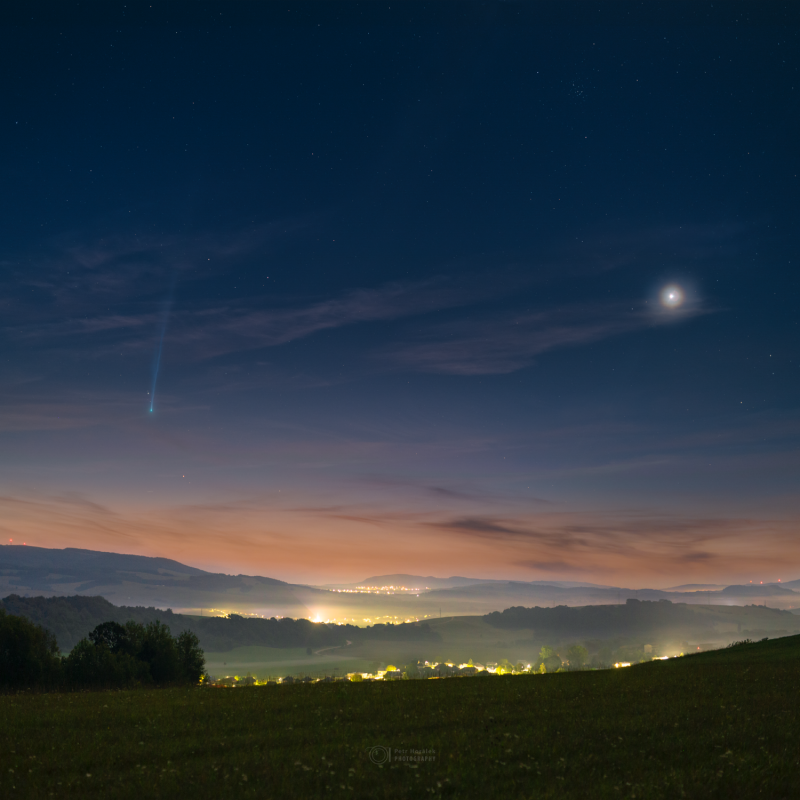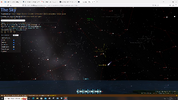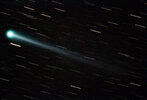I'm using this application.
Sky tonight, if nobody share it before.
You can check object location.
Here is Nishimura
Sky tonight, if nobody share it before.
You can check object location.
Here is Nishimura
Comet Nishimura (C/2023 P1), which appears to have recently survived a close encounter with the Sun, was seen by one of the STEREO-A spacecraft while imaging the Sun on September 19. On the left is the planet Venus and on the right is a CME.


"
THE MILLENNIUM FALCON FLIES AGAIN: Last July, astronomers were surprised when Comet 12P/Pons-Brooks exploded, and the debris formed the shape of the Millennium Falcon. New surprise: It just happened again. On Oct. 5th, the comet exploded with a 100-fold increase in brightness. Once again the debris is shaped like the 'the fastest hunk of junk in the galaxy':
"It appears that Comet 12P/Pons-Brooks is developing the same type of interesting coma as occurred with the last outburst in July," says photographer . Eliot Herman who has been monitoring the outburst from the Utah Desert Observatory.
Richard Miles of the British Astronomical Association thinks 12P may be one of 10 to 20 known comets with active ice volcanoes. "The two 'horns' may be caused by a peculiarly-shaped cryovolcanic vent with some sort of blockage causing material to be expelled with a weird flow pattern," he speculates.
Amateur astronomers can monitor developments. The comet is shining as brightly as an 11th magnitude star, putting it within range of mid-sized backyard telescopes. It is located in the constellation Hercules not far from the bright star Vega. [sky map]"

COMET 12P ERUPTS AGAIN: Comet 12P/Pons-Brooks just did it again. On Halloween, it abruptly brightened almost 100-fold, indicating a new outburst of cryovolcanic activity. Retired biology professor and now-amateur astronomer Eliot Herman has been monitoring the comet and caught the Oct. 31st brightening:Comet 12P/Pons-Brooks has a fresh outburst!

Comet 12P/Pons-Brooks is a Halley-type periodic comet that was first discovered by Jean-Louis Pons on July 12, 1812 and then independently rediscovered by William Robert Brooks in 1883. It has an orbital period of about 71.3 years. During its closest approach to the Sun or perihelion, the comet comes within about 0.78 astronomical units (AU) of the Sun, while at its furthest point, or aphelion, it is located at a distance of about 17.2 AU. Comet 12P/Pons-Brooks is also known for being the probable parent body causing the κ-Draconids meteor shower. Comet 12P/Pons-Brooks will make its return in 2024 and it is expected to reach its maximum brightness (potentially visible to the naked eye) during the month of April. With its closest approach occurring just a few days before a total solar eclipse on April 8, 2024, it presents a unique opportunity for skywatchers to potentially view the comet during the eclipse. However, since the comet's brightness can be unpredictable, there is no guarantee it will be visible, and viewers may need to use binoculars or telescopes to see it. Nevertheless, with the combination of a total solar eclipse and a potentially bright comet passing by, this astronomical event is not to be missed.
Comet 12P/Pons-Brooks is currently in the constellation of Hercules. The current Right Ascension of Comet 12P/Pons-Brooks is 17h 47m 56s and the Declination is +41° 09’ 13” (topocentric coordinates computed for the selected location: [39.5922N, 119.2111W] edit_location_alt). The current estimated magnitude of Comet 12P/Pons-Brooks is 13.72 (JPL), while the latest observed magnitude is 12.4 (COBS).
"
MAJOR CRYOVOLCANIC OUTBURST:
Comet 12P/Pons-Brooks just experienced its biggest outburst yet. On Nov. 14th the cryovolcanic comet abruptly brightened more than 100-fold all the way to magnitude +9.3. Retired biology professor and now-amateur astronomer Eliot Herman has been monitoring the comet almost every night, and he caught the latest eruption hours after it began (lower right):
"There have now been four major outbursts by this comet in 2023: July 20th, Oct. 5th, Nov. 1st, and now Nov. 14th--a trend that looks to be more frequent activity," says Herman.
Astronomers have long known that Comet 12P/Pons-Brooks is unstable. Discovered in 1812 by Pons, and discovered again in 1883 by Brooks, it visits the inner solar system every 71 years. Since the 19th century at least seven significant outbursts have been observed. 2023 is on pace to match that number in one year alone.
This comet has been widely reported in the news as the 'devil comet' due to a pair of devil-like horns that appeared during three prior outbursts. This time might be different. "There is no sign of any dark lane in the coma," reports Nick James, Director of the Comet Section of the British Astronomical Association, who took this picture on Nov. 15th:
"The [comet's atmosphere] seems perfectly circular this time," he says.
Richard Miles of the British Astronomical Association thinks 12P may be one of 10 to 20 known comets with active ice volcanoes. The “magma” is a cold mixture of liquid hydrocarbons and dissolved gasses, all trapped beneath a surface which has the consistency of wax. These bottled-up volatiles can explode when sunlight opens a fissure.
Amateur astronomers are encouraged to monitor developments. Comet 12P is currently in the constellation Hercules not far from the bright star Vega. Will the devil's horns reappear? Submit your photos here."
Another update on 12P/Pons-Brook. As it lights up again like a Christmas Tree topper.IS THIS THE WEIRDEST COMET EVER? Comet 12P/Pons-Brooks continues to baffle astronomers, who are monitoring the aftermath of its 4th major cryo-volcanic eruption in 2023. Previous eruptions in July and October produced "devils horns." The latest and biggest blast on Nov. 14th has transformed the comet into a pearly-green sphere with a dark lane inside:
10 years ago this week, Comet ISON survived its journey past the Sun! Here is it observed by LASCO. ISON will return towards the Sun again in a little under 200 years! #astronomy

